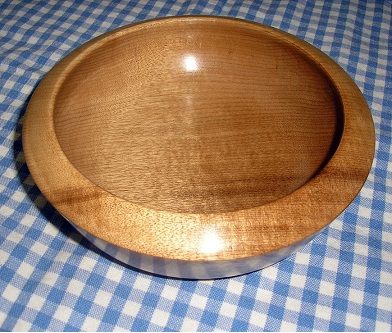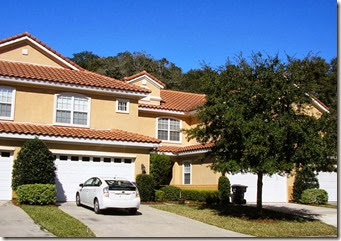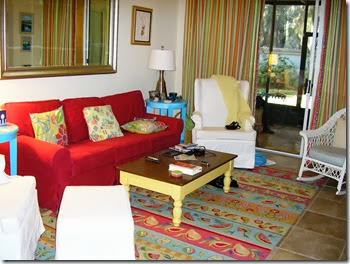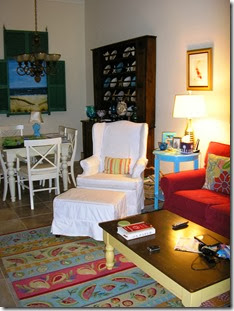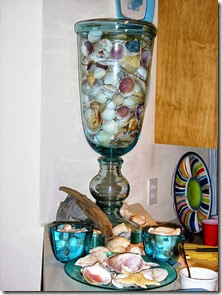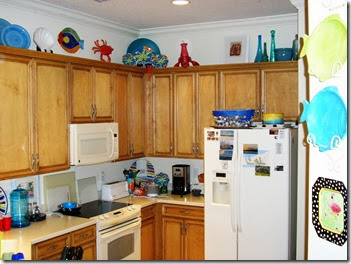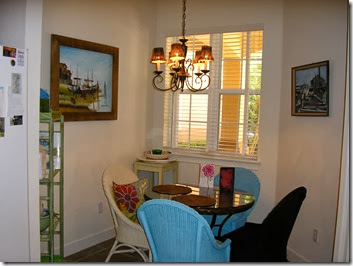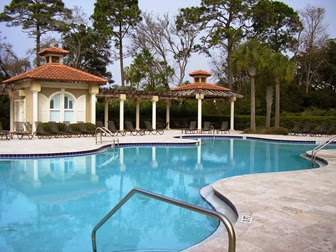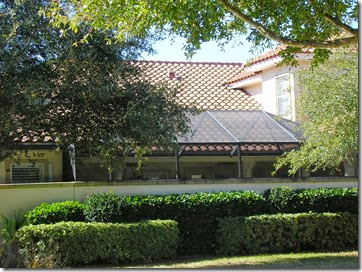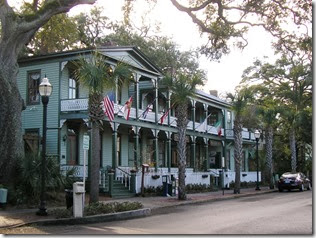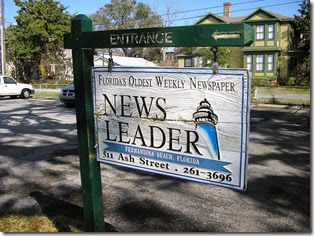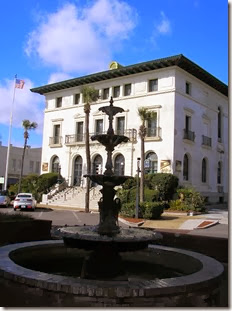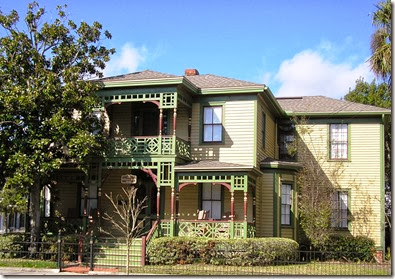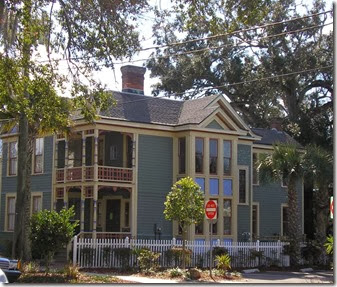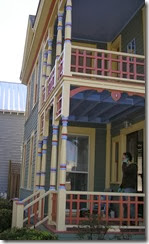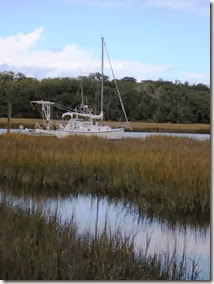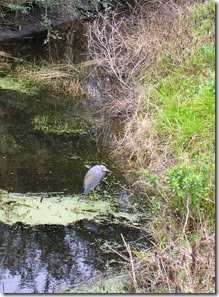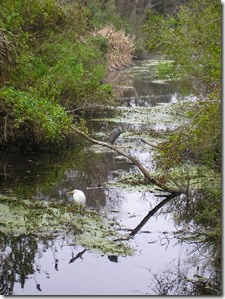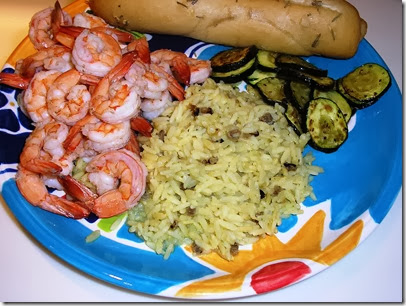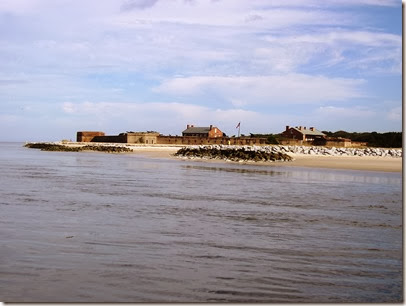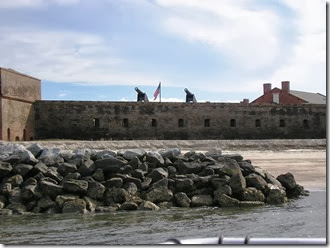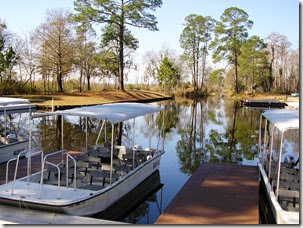My husband and I spent the first 2 weeks of February on Amelia Island, Florida. We rented a 3 bedroom townhouse thru Home Away. We had hoped some family members would join us, but the two of us enjoyed pursuing our interests in a leisurely manner when they were unable to come. The rental was beautifully decorated and spacious and well-equipped, especially the kitchen. It was less than a 1/4 mile to Peter’s Point beach and a few blocks to many bike paths. The Preserve neighborhood was a pseudo-Mediterranean design. Though the units near us were unoccupied second homes, many had year-round residents. This wasn’t primarily a rental neighborhood.
The duplex units had walled courtyards with some screened in. Ours was a quadplex.
What is now Amelia Island was claimed by Spain in 1513, but French Huguenots landed and settled 1562-1565. The Spanish massacred these settlers in 1565 to regain control. They called the island Isla de Santa Maria. They lost possession in 1763 to the British in the Treaty of Paris. Georgia’s governor James Oglethorpe in 1735 started calling the island Amelia after a daughter of George II even though Georgia did not have possession. The British formally called it Egmont when they took over in 1763. In 1783, as the Revolutionary War ended, the British were forced to return the island to Spain. British settlers had to pledge allegiance to Spain or leave. On March 17th, 1812 “Patriots of Amelia Island” an independent group of Americans seized control and raised their own flag. The next day they ceded the island to the United States. However, under protest from Spain, the island returned to Spain. Then in 1817 a Scotsman Sir Gregor MacGregor ran the Spanish off and raised the “Green Cross of Florida”. He was assisted by a man who fought in the Mexican War and who, once MacGregor left, raised the Mexican flag at the fort. The United States stepped in to hold the island in trust for Spain; it became a U.S. territory on July 10, 1821. Subsequently, the Confederate flag flew for awhile. Thus, Amelia Island is known as the Isle of Eight Flags.
Fernandina Beach is the only town on Amelia Island. It takes up the northern and central part. The southern portion has many large resorts including Ritz Carlton and Omni Plantation which are beachside. American Beach near the southern tip was originally a community of cottages owned and rented by black Americans who were segregated out of the predominantly white areas. The town’s golden age was 1870 to 1910 when wealthy Northerners built Victorian homes to get away from harsh winters. When Henry Flagler built a rail line to St. Augustine and other Florida coastal towns, Amelia was bypassed. It had a revival with wood pulp factories which still make containers, particle board, etc. and was a leading shrimping area for many years, but imported shrimp has decimated that industry. With a causeway to the mainland, residents can easily work off the island though. Tourism is now a main draw.
The oldest continuously operated bar in Florida.
This house was used in the Pippi Longstocking movie.
U.S. Post Office
At the northside marina.
We walked a greenway trail in Fernandina Beach one morning.
I was disappointed when the farmers market at Omni Plantation that advertised shrimp from nearby Mayport would be available cancelled because of forecasted rain. We did go to a different farmers market in town where we bought some local zucchini and artisan bread. We had stopped at the Atlantic Seafood Company at the dock on the Amelia River earlier in our trip and knew they had shrimp. An advantage to buying there was that for a small fee they removed the veins and shells. I also bought a spice packet there to use in cooking the shrimp.
It tasted delicious.
We had a good laugh, too. The spices had turned the cooking water red and cloudy. My husband used tongs to retrieve the shrimp. But he twice decided to check while eating dinner to see if there were some he had missed because they were so good he wanted more. Yep. It was like miraculous shrimp that kept appearing each time he dipped into the pot.
We would highly recommend the Amelia River Cruise. It takes you around to see Fort Clinch, then cruises near Cumberland Island. We saw some dolphins. Cumberland Island is part of Georgia, yet it is a few miles from Amelia Island. On this cruise you see the ruins of Dungeness, a large mansion built by Lucy Carnegie. The Carnegies owned most of the island at one time. She had thorough blood horses brought there which now have multiplied and roam wild. We could see some of them in the distance from the boat, but you don’t really get very close. The day of the cruise was our warmest during our stay with 79 degrees.
Fort Clinch
I had thought about going to Saint Augustine, about an hour south, but we had already taken the carriage tour there several years ago, and the rest of the town requires a lot of walking which I was reluctant to do while still recovering from foot surgery. We did, however, go northwest to Okefenokee swamp. We took a 90-minute boat tour. My hubby claims we saw 15 alligators; I didn’t keep count, but often all you saw was a pair of eyes above water level. I was surprised that the large expanses of swamp are called prairies. There are clumps of vegetation throughout, some large enough to support a man, some growing into islands. Okefenokee means trembling earth. All of these clumps are rooted and do tremble in the water. The black water mirrors the vegetation. Lots of birds such as ibis flying overhead.
My husband spent time biking on Amelia Island while I did several beachcombing outings. I was pleased to find some shells quite different from what we gathered on Hilton Head. My favorite shell from last year was a rosy-lined cockle, the only one of its kind. On Amelia, these cockles were one of the most common shells and 4 or 5 times larger than the Hilton Head specimen. I ended up with some terrific whelk pieces, a whole whelk found by my husband, augers, barnacles, angel wings, and sea pens, most of which I had not seen on Hilton Head. The townhouse we rented had a very nice book about Florida beachcombing which helped me identify my finds. I also found two pieces of sea glass, but no fossilized shark’s teeth which people do hunt. The online picture index I used last year also was helpful.
On February 13th, the full moon reflected on the Atlantic ocean was gorgeous. Not to be outdone, the sun gave us a spectacular sunset on February 14th. We ate at Brett’s next to the docks for our Valentine’s lunch (mahi mahi with shrimp) and decided to return to the docks around sunset when the waitress confirmed that there were often lovely sunsets over the Amelia River. We were not disappointed. This was our last evening on Amelia Island and it ended delightfully.
Brett’s where we lunched.
About 30 minutes prior to sunset.
Getting lower in the west.
The northside of the docks bathed in the evening light.
The perfect ending to our Amelia Island stay.
